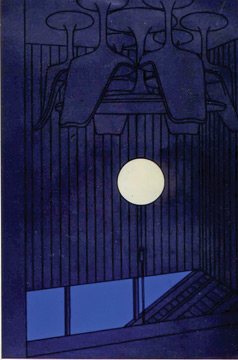Patrick Caulfield's innovative approach to colour
by Gwen Herat
Patrick Caulfield's innovative approach to colour and composition was
developed the moment he started painting professionally. He had to
identify where his art was heading and be focussed on a singular theme.
He explored a range of emotional responses as he experimented upon
their combinations with recognisable forms fragmented to abstraction.
And, there was no looking back.
Being a leading artist of his generation, Caulfield had very little
competition from his contemporaries. He re-invigorated traditional
genres such as still life or object drawing.
|

Dining Recess painted in 1972. Oil on canvas, at the Arts
Council Collection in Southbank Centre, London. |
After coming into prominence in the mid-1960s he became associated
with pop art but found that was not what art lovers expect from a
traditional painter and weaned himself off to look at himself as a
formal artist.
He studied at the Royal College of Art and through his participation
at the Whitechapel Gallery, London in 1964, he was focused on pop music
which he dropped off no sooner he began. He was greatly influenced by
the traditions of earlier continental artists such as Georges Baraque,
Juan Gris and Fernad Leger. Experts say there is a semblance of their
art in his.
Outlines
He was a bit strange, quiet removed from many because his paintings
were characterised by flat area of colour with objects defined by simple
outlines. As he gained more experience, he combined different artistic
styles to create highly complex paintings that played with definitions
of reality and artifice.
Highly engaged with subtle shift in subject matter to topics directly
engaged with cintemporary landscape and the representation of modern
life. This type of attitude remained central to his art for the rest of
his life.
Several of his paintings made a direct reference to compositional
devices found in the carefully constructed still life of the cubist
painter, Juan Gris. Caulfield was so carried away by his work that
resulted in the Portrait of Juan Gris in 1963.
This is one of the very few images he made of a figure which was done
on board
and hangs Pallant House Gallery, Chichester. He also began working
with a large format, presenting flat, linear images of everyday objects
upon empty settings.
Rather queer, I thought. However, with simple background of flat
colour, he developed his signature use of graphic black outlines to
create pictorial depth. He was also a lover of buildings and structures
and focussed on their interiors. This made him to admire the American
painter, Edward Hopper whose frozen quality of time in his interiors.
In the 70s he explored the language of painting that combined
different styles of representation within the same work.
|

Patrick Caulfield at his best. Window at Night. Painted in
1969, oil on canvas, at a private collection. |
The coll precision of his earlier paintings were subverted and became
highly realistic. To him it was like an Ďaliení style which contrasted
with his own and subtly complicated the definitions of interior and
exterior.
He played with conventions of taste and kitsch because much of the
scenes suggested deserted transient pleasure. He was not concerned of
its overall effect that later was to have an unpleasant effect on his
paintings.
Instead, he was very logical with the space provided for structural
painting. Those are the moments that he appeared eccentric. But
throughout his career his interior scenes revealed different forms and
sources and used their validity to suggest human presence.
He became increasingly involved in creating his own sharp divisions
with simple brushwork devices.
The intensity of his colour separation baffled the senior painters of
his time who found it difficult to understand in which direction he was
taking British art after he commenced abstracts and fragments in
compositions.
It took a long time for British critics to give him their nod. Yet
they were not sure whether if was an abstractist or a cubist. But he was
very insistent about his colour combinations that were restricted two or
three to paint a large canvas. He never adapted any source of imagery
from reproductions.
Art history was foreign to him. The flashes of arabesque colours in
his brain, rotated and revolved long enough to put them on canvas. There
was no romance, no poetry nor music in his brush strokes. They were
brusque, hard and at times a strain on eyes.
But how did Caulfield survive to climb the ladder of British art?
Perhaps his disregard for convention and a chip on his shoulder that he
carried negatively towards his contemporaries who failed to gain
popularity or the critics on to their side.
Patrick Caulfield was born in 1936 and died in 2005. |

